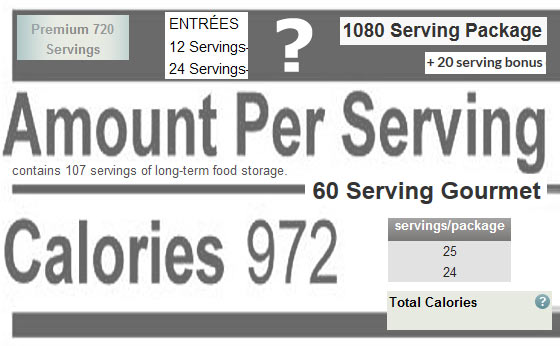Emergency Food Calories – How Much Do You Need?
How many calories a day to survive during a time of emergency?How many calories do you need each day?
In addition to general nutrition you need to understand how many calories that your body needs to survive.
Your body burns calories in three different ways:
Metabolism
Your body needs energy to survive — even when you are sleeping. Your heart is constantly pumping, your body is working at maintaining a normal body temperature, your brain is always ‘on’, damage is being repaired behind the scenes within the body — and these body systems require fuel. Roughly 60% to 70% of the calories you burn every day is to keep all of your body systems functioning.
Physical Activity
Your body burns calories through ANY sort of physical activity and manual labor, ranging from simply walking to strenuous physical exercise. The number of calories you burn from physical activity might range from 25% to 40% the total amount of calories you burn in a day.
Digesting Food
Your body also uses energy to digest the food you eat, although it only accounts for about 5% to 10% of calories burned.
Calorie Requirements Vary With Physical Activity
If you consume fewer calories than your body needs, you will create a ‘calorie deficit’ — and your body will attempt to make up the difference by depleting-metabolizing (‘burning’) your excess body fat. While this may be desirable while dieting, it is undesirable (a calorie deficiency) in a survival situation.
A physical work day will require more calories than sitting around all day. When planning for emergency preparedness, it’s best to assume you will need more rather than less. In general, teenage and adult males may need 2800 calories per day, while teenage and adult females may require 2200, and children 13 and under may use 1400 calories.
Going by these figures, an adult male needs more than 900 calories per meal, assuming three meals per day, for an active lifestyle.
The following two examples may give you a general idea of caloric needs and how they vary with physical activity.
A 200 pound, 6’2″ man 40 years of age who is ‘lightly active’ during a typical day will require 2,700 calories to maintain body systems function without gaining or losing weight. That same person will require 3,400 if he is ‘very active’ and 3,800 if ‘extremely active’.
A 140 pound, 5’7″ woman 40 years of age who is ‘lightly active during a typical day will require 1,900 calories, but if ‘very active’ will require 2,400, and if ‘extremely active’ will require 2,600 to maintain body systems function without gaining or losing weight.
General Daily Calorie Requirements
These numbers vary with gender, age, environment, physical condition and activity. There are charts and resources online to narrow down your own specific requirements, but here is a general range…
Male, 5’11”, 190 pounds, lightly active
Age-20: 2,800
Age-30: 2,700
Age-40: 2,600
Age-50: 2,500
Age-60: 2,400
Age-70: 2,300
Female, 5’5″, 150 pounds, lightly active
Age-20: 2,100
Age-30: 2,000
Age-40: 1,900
Age-50: 1,900
Age-60: 1,800
Age-70: 1,800
How many calories a day
As a very general rule of thumb, most people say “about 2,000 calories a day” at a minimum.
Note: With regards to survival preparedness, the generality of daily caloric intake is only part of the food-storage bigger picture. Nutrition, balance, variety, are additional (important) factors which will affect one’s overall food health (among other things).
The information listed here is to provide you with the general knowledge that your body needs a given amount of calories to survive. Use this to better understand your long term food storage (and your equivalent ‘survival days’), or the emergency food kits that you may consider purchasing (don’t go by number of servings!). Count the calories. Nutrition and Flavor matters too, but, I’m just sayin…
Oh, here’s a statistic for you…
2,000 calories per day per person equals about 60,800 for a survival month, or about 730,000 for a survival year. Got enough?
[ Read: How Many Calories In A Pound Of Rice, Beans, Wheat ]
[ Read: Rice and Beans, A Survival Combination ]

